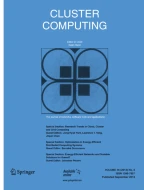Abstract
According to the fact that cloud servers have different energy consumption on different running states, as well as the energy waste problem caused by the mismatching between cloud servers and cloud tasks, we carry out researches on the energy optimal method achieved by a priced timed automaton for the cloud computing center in this paper. The priced timed automaton is used to model the running behaviors of the cloud computing system. After introducing the matching matrix of cloud tasks and cloud resources as well as the power matrix of the running states of cloud servers, we design a generation algorithm for the cloud system automaton based on the generation rules and reduction rules given ahead. Then, we propose another algorithm to settle the minimum path energy consumption problem in the cloud system automaton, therefore obtaining an energy optimal solution and an energy optimal value for the cloud system. A case study and repeated experimental analyses manifest that our method is effective and feasible.
Similar content being viewed by others
References
J. Glanz. Google details, and defends, its use of electricity. NewYork Times[Online], http://www.nytimes.com/2011/09/09/technology/google-details-and-defends-its-use-of-electricity.html. Sept 2011
Pedram, M.: Energy-efficient datacenters. IEEE Trans. Comput.-Aided Des. Integr. Circuits Syst. 31(10), 1465–1484 (2012)
Chuang, Lin, Yuan, Tian, Min, Yao: Green network and green evaluation: Mechanism, modeling and evaluation. Chin. J. Comput. 34(4), 593–612 (2011)
Venkatachalam, V., Franz, M.: Power reduction techniques for microprocessor Systems. ACM Comput. Surv. 37(3), 195–237 (2005)
K. H. Kim, R. Buyya, J. Kim. Power aware scheduling of bag-of-tasks applications with deadline constraints on DVS-enabled clusters. In: Seventh IEEE International Symposium on Cluster Computing and the Grid, 2007, pp. 541–548
Goh, L.K., Veeravalli, B., Viswanathan, S.: Design of fast and efficient energy-aware gradient-based scheduling algorithms. IEEE Trans. Parallel Distrib. Syst. 20(1), 1–12 (2009)
Lee, Y.C., Zomaya, A.Y.: Energy conscious scheduling for distributed computing systems under different operating conditions. IEEE Trans. Parallel Distrib. Syst. 22(8), 1374–1381 (2011)
Yi-Ming, Tan, Guo-Sun, Zeng, Wei, Wang: Policy of energy optimal management for cloud computing platform with stochastic tasks. J. Softw. 23(2), 266–278 (2012)
Rasmussen, J.I., Larsen, K.G., Subramani, K.: On using priced timed automata to achieve optimal. Form. Methods Syst. Des. 29(1), 97–114 (2006)
A. Lungu, P. Bose, et al. Multicore power management: Ensuring robustness via early-stage formal verification. In:Proceeding of the Seventh IEEE/ACM Internatinal Conference on Formal Methods Models Codesign, 2009, pp. 78–87
Nocco, S., Quer, S.: A novel SAT-based approach to the task graph cost-optimal scheduling problem. IEEE Trans. Comput.-Aided Des. Integr. Circuits Syst. 29(12), 2027–2040 (2010)
Alur, R., Dill, D.L.: A theory of timed automata. Theor. Comput. Sci. 126(2), 183–235 (1994)
Behrmann, G., Fehnker, A., et al.: Minimum-cost reachability for priced timed automata. Lect. Notes Comput. Sci. 2034, 147–161 (2001)
Kwok, Y.K., Ahmad, I.: Static scheduling algorithms for allocating directed task graphs to multiprocessors. ACM Comput. Surv. 31(4), 406–471 (1999)
Acknowledgments
The authors are grateful to the anonymous reviewers for their insightful comments and suggestions. The research supported by the National High Technology Research and Development Program of China (863 program) under Grant of 2009AA012201, the National Natural Science Foundation of China under Grant of 61272107, 61202173, and 61103068, the Program of Shanghai Subject Chief Scientist under grant of 10XD1404400, the special Fund for Fast Sharing of Science Paper in Net Era by CSTD under Grant of 20110740001.
Author information
Authors and Affiliations
Corresponding author
Rights and permissions
About this article
Cite this article
Deng, Z., Zeng, G., He, Q. et al. Using priced timed automaton to analyse the energy consumption in cloud computing environment. Cluster Comput 17, 1295–1307 (2014). https://doi.org/10.1007/s10586-014-0378-8
Received:
Revised:
Accepted:
Published:
Issue Date:
DOI: https://doi.org/10.1007/s10586-014-0378-8
